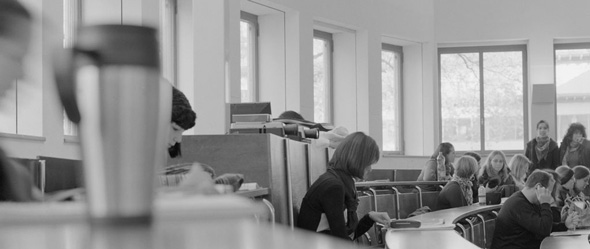
Rights and opportunities for women and men
Legal equality does not by itself mean equal opportunities. The ability to individually exercise rights that are legally granted to everyone is unevenly distributed depending on social, ethnic, or gender identities or ascriptions. Since the late 1980s, university policies on gender equality have sought to address gender-specific disparities in teaching and the academic system.
Legally, women and men now have equal access to universities and academia. In practice, however, men still have advantages in claiming academic and career opportunities. In a 2007 status report, the Swiss state secretary for education and research reached a clear finding: in addition to horizontal segregation by discipline, the academic world is still structured by vertical segregation by rank.
Vertical segregation
Although the proportion of women has slowly increased at all levels of the university hierarchy in recent years, the higher the level, the lower the proportion of women. While women made up around 50 percent of enrollments at Swiss universities in 2005, they constituted 45 percent of graduates, 40 percent of completed doctorates, 23 percent of habilitations, and just 12 percent of professorships. At the University of Basel in 2005, 86 percent of full professorships were held by men. Women face particular challenges when advancing up the academic career ladder. The state secretary for education and research places Switzerland twenty-ninth in an international comparison: only four other European countries have worse records for women’s participation in science and research.
Vertical gender segregation is a long-standing, stubborn problem. Since the 1970s, demands have been made for measures to “promote women,” meant to counteract the structural disadvantages faced by women in male-dominated areas and help achieve equal opportunities in practice. Early measures of this kind often adhered to male norms. Since the 1990s, there have been further demands for similar policies for men. The situation of both women and men, it is argued, needs to be considered in developing and implementing policies for gender equality policies. Male norms, too, have come to be seen as a topic of debate and open to political change.
It has been acknowledged that measures to promote women have only limited effectiveness if implemented in an academic system that hews closely to traditional gender roles and the standard career paths of men. The redistribution of family responsibilities in partnerships must therefore be included in political strategies, along with the compatibility of family duties with job profiles, academic career paths, and criteria for academic success. Policies for gender equality are a project that must address both genders.
“Nothing is achieved”
Gender equality initiatives began at the University of Basel in the late 1980s. Responding to pressure from women assistants and students, an ad hoc Senate commission “Women at the University” was established in 1988. It developed a list of proposals to improve the situation of women at the University of Basel, which were then adopted by the Senate on 19 December 1990. The key passage stated: “Women and men have equal opportunities in undergraduate and postgraduate studies, in appointments, and employment. The university authorities will implement suitable measures to ensure equal opportunities and promote women, particularly to increase the proportion of teaching staff who are women.” This principled declaration was soon incorporated into the university’s official mission statement.
In 1991, the provisional Senate commission was made permanent. The twelve-member body included students, assistant professors, and tenured professors. The commission was tasked with advancing and implementing the Senate’s resolutions on gender equality and women’s promotion. The report they presented in 1993 after five years of work was titled “How Nothing Is Achieved despite Clear Goals and Serious Efforts.” The implementation of the university’s declared intention encountered obstacles and resistance. In 1993, Basel-City’s Governing Council declined to financially support the establishment of a university daycare center and the position of a women’s representative.
Firm and binding
In the course of the university reform, the principle of equal opportunity and the tool of promoting women were incorporated in 1996 into the objectives of the newly established University Act (Article 6) and the University Statute (Article 5). Since then, these principles have been a firm and binding part of the university’s legal foundation. Article 18 of the 2007 agreement between Basel-City and Basel-Countryside regulating the joint sponsorship of the university further stipulates gender equality, measures to promote gender equality, and support for balancing studies, career, and family.
To implement this mandate for equality, the Office for Equal Opportunity was established in 1998. It develops conceptual and organizational strategies and implements corresponding measures. Understanding that achieving equal opportunity cannot be delegated to a single office but represents a broad, university-wide task, the office was placed directly under the rector. Operational responsibility ultimately lies with numerous individuals and committees at all levels, supported by the office on the path to greater equality.
University policies, mentoring, and work-life balance
The office primarily engages in university policy, career promotion, and fostering compatibility of studies or work with family responsibilities. By 2011, Switzerland’s Federal Program for Equal Opportunity, initiated in 2000 to promote gender equality in academia, was in its third phase. The goal at the time was to increase the proportion of female professors to 25 percent and further reduce the underrepresentation of women in university decision-making bodies. The federal program also included a project addressing “work-life balance” issues and considering the situation of “dual career couples.” The Office for Equal Opportunity supports the federal program at the University of Basel.
A particular focus of the office is on improving conditions for young women researchers. Since 2000, mentoring programs for different target groups have supported young women researchers at all qualification levels (step!, Diss+, WIN, Frame Plus, Mentoring Deutschschweiz). Additionally, women researchers can acquire key qualifications in targeted training courses and address career strategy issues. Mentoring programs operating as gender equality measures aim not only to positively impact the individual careers of women but also to bring about structural changes in gender relations within the academic system.


